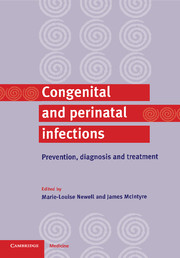Book contents
- Frontmatter
- Contents
- List of contributors
- Preface
- Part I General issues
- Part II Specific infections
- 5 Rubella infection in pregnancy
- 6 Perinatal Group B streptococcal infections
- 7 Mother-to-child transmission of cytomegalovirus
- 8 Varicella
- 9 Herpes simplex
- 10 Vertical transmission of hepatitis viruses
- 11 Papillomavirus infections as a perinatal problem: diagnosis, prevention and management
- 12 HIV-1 infection
- 13 Syphilis: prevention, diagnosis and management during pregnancy and infancy
- 14 The other sexually transmitted diseases
- 15 Toxoplasmosis
- 16 Neonatal sepsis
- Index
7 - Mother-to-child transmission of cytomegalovirus
Published online by Cambridge University Press: 06 July 2010
- Frontmatter
- Contents
- List of contributors
- Preface
- Part I General issues
- Part II Specific infections
- 5 Rubella infection in pregnancy
- 6 Perinatal Group B streptococcal infections
- 7 Mother-to-child transmission of cytomegalovirus
- 8 Varicella
- 9 Herpes simplex
- 10 Vertical transmission of hepatitis viruses
- 11 Papillomavirus infections as a perinatal problem: diagnosis, prevention and management
- 12 HIV-1 infection
- 13 Syphilis: prevention, diagnosis and management during pregnancy and infancy
- 14 The other sexually transmitted diseases
- 15 Toxoplasmosis
- 16 Neonatal sepsis
- Index
Summary
The virus
Cytomegalovirus (CMV) is an enveloped DNA virus and a member of the herpes family which also includes herpes simplex, Epstein–Barr and varicella-zoster viruses. Like other herpes viruses, once primary infection has occurred the virus establishes itself in the host in a latent form, possibly in peripheral blood mononuclear cells, and may periodically reactivate (Jafari et al., 1995). During active infection CMV is found in epithelial cells (Griffiths & Grundy, 1998). Infection is controlled by cellular and humoral immune responses, with the cellular responses being the most important and much of the tissue damage associated with CMV infection is probably due to the immune mediated inflammatory reaction to infected cells expressing CMV antigen (Griffiths & Grundy, 1998). CMV is probably transmitted through infected secretions coming into contact with mucous membranes, but not through intact skin. Droplet infection seems to play a minor role. The virus is unstable outside the body and is vulnerable to ordinary soaps, detergents, commonly used disinfectants and heat. Normal hygienic procedures should thus substantially reduce, or eliminate, the risk of transmission of infection.
Both primary and recurrent (with the same or a different strain) infections are associated with viral shredding in body fluids, including urine, saliva, semen, cervical secretions and breast milk. In healthy individuals symptoms of CMV infection are usually mild or not apparent and rarely cause serious illness. However, infection can be life threatening in immunocompromised individuals and in very premature infants, and when acquired in pregnancy it can result in fetal damage (Fig. 7.1).
- Type
- Chapter
- Information
- Congenital and Perinatal InfectionsPrevention, Diagnosis and Treatment, pp. 122 - 134Publisher: Cambridge University PressPrint publication year: 2000
- 1
- Cited by



